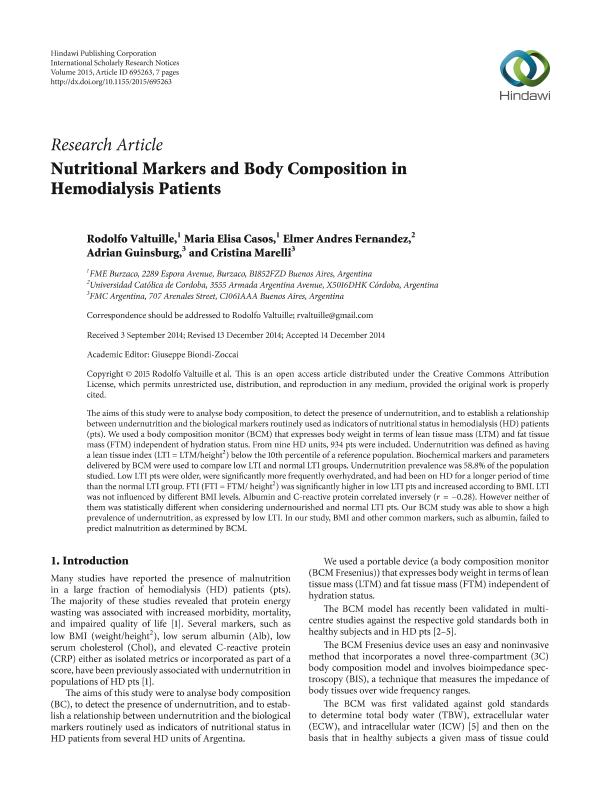Mostrar el registro sencillo del ítem
dc.contributor.author
Valtuille, Rodolfo

dc.contributor.author
Casos, Maria Elisa
dc.contributor.author
Fernandez, Elmer Andres

dc.contributor.author
Guinsburg, Adrian
dc.contributor.author
Marelli, Cristian
dc.date.available
2018-09-17T15:45:16Z
dc.date.issued
2015-01
dc.identifier.citation
Valtuille, Rodolfo; Casos, Maria Elisa; Fernandez, Elmer Andres; Guinsburg, Adrian; Marelli, Cristian; Nutritional markers and body composition in hemodialysis patients; Hindawi Publishing Corporation; International Scholarly Research Notices; 2015; 1-2015; 1-8
dc.identifier.issn
2356-7872
dc.identifier.uri
http://hdl.handle.net/11336/59867
dc.description.abstract
The aims of this study were to analyse body composition, to detect the presence of undernutrition, and to establish a relationship between undernutrition and the biological markers routinely used as indicators of nutritional status in hemodialysis (HD) patients (pts). We used a body composition monitor (BCM) that expresses body weight in terms of lean tissue mass (LTM) and fat tissue mass (FTM) independent of hydration status. From nine HD units, 934 pts were included. Undernutrition was defined as having a lean tissue index (LTI = LTM/height2) below the 10th percentile of a reference population. Biochemical markers and parameters delivered by BCM were used to compare low LTI and normal LTI groups. Undernutrition prevalence was 58.8% of the population studied. Low LTI pts were older, were significantly more frequently overhydrated, and had been on HD for a longer period of time than the normal LTI group. FTI (FTI = FTM/ height2) was significantly higher in low LTI pts and increased according to BMI. LTI was not influenced by different BMI levels. Albumin and C-reactive protein correlated inversely (). However neither of them was statistically different when considering undernourished and normal LTI pts. Our BCM study was able to show a high prevalence of undernutrition, as expressed by low LTI. In our study, BMI and other common markers, such as albumin, failed to predict malnutrition as determined by BCM.
dc.format
application/pdf
dc.language.iso
eng
dc.publisher
Hindawi Publishing Corporation

dc.rights
info:eu-repo/semantics/openAccess
dc.rights.uri
https://creativecommons.org/licenses/by/2.5/ar/
dc.subject
HEMODIALYSIS
dc.subject
BIOMARKERS
dc.subject.classification
Otras Biotecnologías de la Salud

dc.subject.classification
Biotecnología de la Salud

dc.subject.classification
CIENCIAS MÉDICAS Y DE LA SALUD

dc.title
Nutritional markers and body composition in hemodialysis patients
dc.type
info:eu-repo/semantics/article
dc.type
info:ar-repo/semantics/artículo
dc.type
info:eu-repo/semantics/publishedVersion
dc.date.updated
2018-09-04T16:28:25Z
dc.journal.volume
2015
dc.journal.pagination
1-8
dc.journal.pais
Egipto

dc.journal.ciudad
El Cairo
dc.description.fil
Fil: Valtuille, Rodolfo. Fresenius Medical Care; Argentina
dc.description.fil
Fil: Casos, Maria Elisa. Fresenius Medical Care; Argentina
dc.description.fil
Fil: Fernandez, Elmer Andres. Consejo Nacional de Investigaciones Científicas y Técnicas. Centro de Investigación y Desarrollo en Inmunología y Enfermedades Infecciosas. Universidad Católica de Córdoba. Centro de Investigación y Desarrollo en Inmunología y Enfermedades Infecciosas; Argentina
dc.description.fil
Fil: Guinsburg, Adrian. FME Burzaco; Argentina
dc.description.fil
Fil: Marelli, Cristian. FME Burzaco; Argentina
dc.journal.title
International Scholarly Research Notices
dc.relation.alternativeid
info:eu-repo/semantics/altIdentifier/url/https://www.hindawi.com/archive/2015/695263/
dc.relation.alternativeid
info:eu-repo/semantics/altIdentifier/doi/http://dx.doi.org/10.1155/2015/695263
Archivos asociados
